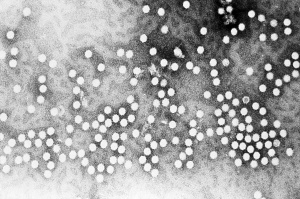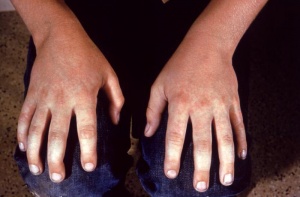Abnormal Development - Parvovirus
| Embryology - 1 May 2024 |
|---|
| Google Translate - select your language from the list shown below (this will open a new external page) |
|
العربية | català | 中文 | 中國傳統的 | français | Deutsche | עִברִית | हिंदी | bahasa Indonesia | italiano | 日本語 | 한국어 | မြန်မာ | Pilipino | Polskie | português | ਪੰਜਾਬੀ ਦੇ | Română | русский | Español | Swahili | Svensk | ไทย | Türkçe | اردو | ייִדיש | Tiếng Việt These external translations are automated and may not be accurate. (More? About Translations) |
Introduction
Human parvovirus B19 (Latin, parvo = poor), infection is also called "fifth disease" and occurs mainly in children. Pets (dogs and cats) have their own animal parvoviruses that do not infect humans.
Parvovirus B19 (B19V) is the only member of the Parvoviridae family known to cause disease in humans and is a single-strand 5,594 nucleotide DNA Class II virus. The virions have a diameter of 22-25 nm and are transmitted by respiratory secretions between humans and can also cross the placenta. Virus replication requires help from either host cells or other viruses.
Some Recent Findings
|
Fifth Disease
Historic terminology referring to the fifth in a group of once-common childhood diseases (the other four are measles, rubella, scarlet fever and Dukes' disease) that all have similar rashes.
- First disease - measles
- Second disease - scarlet fever (Streptococcus pyogenes)
- Third disease - rubella
- Fourth disease - Dukes' disease is also a historic term for a febrile disease of childhood (suggested as Staphylococcus aureus)
- Fifth disease - Parvovirus
B19
Professor Yvonne Cossart (University of Sydney, Bosch Professor of Infectious Diseases)
Yvonne Cossart coined the nomenclature "B19", from the well on a microtitre (microtiter) plate where the virus antigen was first discovered in blood.[2] Microtitre plates are generally organised by rows (alphabetically) and columns (numerically).
- "A parvovirus-like antigen has been found in sera of nine healthy blood-donors and two patients. Its pathogenicity is unknown, but 30% of adults possess specific antibody. The new agent can be confused with hepatitis-B antigen both morphologically and serologically."
Hydrops Fetalis
The following information is based on infection in a pregnant woman followed by transplacental transmission to the fetus.[3]
- Most parvovirus B19 infections during pregnancy do not lead to loss of the fetes.
- estimated 30% risk of transplacental infection among women who are infected with parvovirus B19 during pregnancy
- Transmission to the fetus can lead to miscarriage or hydrops fetalis.
- estimated 5 to 9 % risk of fetal loss.
- Infection during the second trimester poses the greatest risk of hydrops fetalis.
- Parvovirus infects the fetal liver that is involved with early erythrocyte production.
- Seroprevalence data indicate that about half of pregnant women are susceptible to parvovirus infection.
References
Reviews
<pubmed>21040396</pubmed>
Articles
<pubmed>19335188</pubmed> <pubmed>19786782</pubmed> <pubmed>18464909</pubmed> <pubmed>17252527</pubmed> <pubmed>12583652</pubmed> <pubmed>10770616</pubmed> <pubmed>9325515</pubmed>
Search Pubmed
June 2010
Search Pubmed: Parvovirus B19 | fifth disease | Parvovirus
| Environmental Links: Introduction | low folic acid | iodine deficiency | Nutrition | Drugs | Australian Drug Categories | USA Drug Categories | thalidomide | herbal drugs | Illegal Drugs | smoking | Fetal Alcohol Syndrome | TORCH | viral infection | bacterial infection | fungal infection | zoonotic infection | toxoplasmosis | Malaria | maternal diabetes | maternal hypertension | maternal hyperthermia | Maternal Inflammation | Maternal Obesity | hypoxia | biological toxins | chemicals | heavy metals | air pollution | radiation | Prenatal Diagnosis | Neonatal Diagnosis | International Classification of Diseases | Fetal Origins Hypothesis |
External Links
External Links Notice - The dynamic nature of the internet may mean that some of these listed links may no longer function. If the link no longer works search the web with the link text or name. Links to any external commercial sites are provided for information purposes only and should never be considered an endorsement. UNSW Embryology is provided as an educational resource with no clinical information or commercial affiliation.
Glossary Links
- Glossary: A | B | C | D | E | F | G | H | I | J | K | L | M | N | O | P | Q | R | S | T | U | V | W | X | Y | Z | Numbers | Symbols | Term Link
Cite this page: Hill, M.A. (2024, May 1) Embryology Abnormal Development - Parvovirus. Retrieved from https://embryology.med.unsw.edu.au/embryology/index.php/Abnormal_Development_-_Parvovirus
- © Dr Mark Hill 2024, UNSW Embryology ISBN: 978 0 7334 2609 4 - UNSW CRICOS Provider Code No. 00098G


